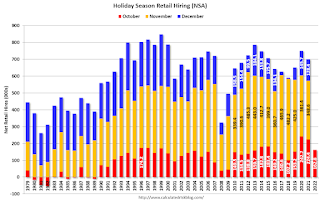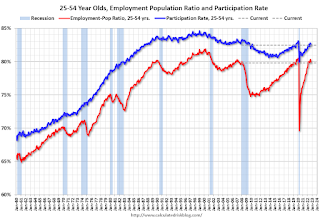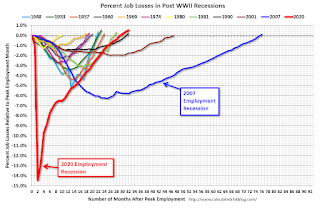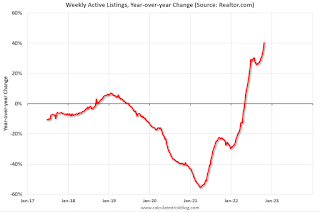by Calculated Risk on 11/04/2022 02:11:00 PM
Friday, November 04, 2022
Realtor.com Weekly Inventory Up 40% Year-over-year; Now Above Same Week in 2020
Today, in the Calculated Risk Real Estate Newsletter: Realtor.com Weekly Inventory Up 40% Year-over-year; Now Above Same Week in 2020
A brief excerpt:
Here is a graph comparing the year-over-year change in the Realtor.com active monthly data to the inventory data from the National Association of Realtors (NAR). The dashed line is Realtor.com’s estimate of total inventory including pendings.There many more comments in the article. You can subscribe at https://calculatedrisk.substack.com/
t appears the NAR includes some pending sales in their inventory data, and that accounts for the divergence in the year-over-year change over the last 2 years.
Housing economist Tom Lawler noted this in early 2021:"As I’ve noted before, the inventory measure in most publicly-released local realtor/MLS reports excludes listings with pending contracts, but that is not the case for many of the reports sent to the NAR (referred to as the “NAR Report!”), Since the middle of last Spring inventory measures excluding pending listings have fallen much more sharply than inventory measures including such listings, and this latter inventory measure understates the decline in the effective inventory of homes for sale over the last several months."The divergence between the NAR and other measures will probably disappear as the housing market slows.
The bottom line is inventory is still low, increasing, and the pace of growth has picked up again in recent weeks.
Early Q4 GDP Tracking and Upward Revisions to Q3 GDP
by Calculated Risk on 11/04/2022 12:26:00 PM
A wide range of Q4 estimates, from 0.7% to 3.6%. It looks like Q3 GDP will be revised up in the second release.
From BofA:
[1.0% in Q4] Overall, the data since our last weekly publication when the BEA’s advance estimate of US 3Q GDP growth was realeased, moved up our 3Q GDP tracking estimate from 2.6% q/q saar (seasonally adjusted annual rate) to 3.1% q/q saar [Nov 4th estimate]From Goldman:
emphasis added
Following today’s data, we lowered our Q4 GDP tracking estimate by two tenths to +0.7% (qoq ar) but boosted our past-quarter tracking estimate for Q3 by the same amount to +3.1%, compared to +2.6% as originally reported. [Nov 3rd estimate]And from the Altanta Fed: GDPNow
The GDPNow model estimate for real GDP growth (seasonally adjusted annual rate) in the fourth quarter of 2022 is 3.6 percent on November 3, up from 2.6 percent on November 1. [Nov 3rd estimate]
Comments on October Employment Report
by Calculated Risk on 11/04/2022 09:24:00 AM
The headline jobs number in the October employment report was above expectations, and employment for the previous two months was revised up by 29,000, combined. The participation rate decreased, and the unemployment rate increased to 3.7%.
In October, the year-over-year employment change was 5.30 million jobs.
Seasonal Retail Hiring
Typically, retail companies start hiring for the holiday season in October, and really increase hiring in November. Here is a graph that shows the historical net retail jobs added for October, November and December by year.
 This graph really shows the collapse in retail hiring in 2008. Since then, seasonal hiring had increased back close to more normal levels. Note: I expect the long-term trend will be down with more and more internet holiday shopping.
This graph really shows the collapse in retail hiring in 2008. Since then, seasonal hiring had increased back close to more normal levels. Note: I expect the long-term trend will be down with more and more internet holiday shopping.Retailers hired 163 thousand workers Not Seasonally Adjusted (NSA) net in October. This was down from the previous two years and suggests lower increase in real retail sales this holiday season than the previous two years.
Prime (25 to 54 Years Old) Participation
 Since the overall participation rate is impacted by both cyclical (recession) and demographic (aging population, younger people staying in school) reasons, here is the employment-population ratio for the key working age group: 25 to 54 years old.
Since the overall participation rate is impacted by both cyclical (recession) and demographic (aging population, younger people staying in school) reasons, here is the employment-population ratio for the key working age group: 25 to 54 years old.The 25 to 54 participation rate decreased in October to 82.5% from 82.7% in September, and the 25 to 54 employment population ratio decreased to 79.8% from 80.2% the previous month.
Part Time for Economic Reasons
 From the BLS report:
From the BLS report:"The number of persons employed part time for economic reasons was little changed at 3.7 million in October. These individuals, who would have preferred full-time employment, were working part time because their hours had been reduced or they were unable to find full-time jobs."The number of persons working part time for economic reasons decreased in October to 3.577 million from 3.843 million in September. This is below pre-recession levels and the fewest part time workers (for economic reasons) in over 20 years.
These workers are included in the alternate measure of labor underutilization (U-6) that increased to 6.8% from 6.7% in the previous month. This is down from the record high in April 22.9%, and is close to the lowest level on record for this measure since 1994. This measure is below the level in February 2020 (pre-pandemic).
Unemployed over 26 Weeks
 This graph shows the number of workers unemployed for 27 weeks or more.
This graph shows the number of workers unemployed for 27 weeks or more. According to the BLS, there are 1.165 million workers who have been unemployed for more than 26 weeks and still want a job, up from 1.067 million the previous month.
This is back to pre-pandemic levels.
Summary:
The headline monthly jobs number was above expectations and employment for the previous two months was revised up by 29,000, combined.
October Employment Report: 261 thousand Jobs, 3.7% Unemployment Rate
by Calculated Risk on 11/04/2022 08:40:00 AM
From the BLS:
Total nonfarm payroll employment increased by 261,000 in October, and the unemployment rate rose to 3.7 percent, the U.S. Bureau of Labor Statistics reported today. Notable job gains occurred in health care, professional and technical services, and manufacturing.
...
The change in total nonfarm payroll employment for August was revised down by 23,000, from +315,000 to +292,000, and the change for September was revised up by 52,000, from +263,000 to +315,000. With these revisions, employment gains in August and September combined were 29,000 higher than previously reported.
emphasis added
 Click on graph for larger image.
Click on graph for larger image.The first graph shows the job losses from the start of the employment recession, in percentage terms.
The current employment recession was by far the worst recession since WWII in percentage terms.
 The second graph shows the year-over-year change in total non-farm employment since 1968.
The second graph shows the year-over-year change in total non-farm employment since 1968.In October, the year-over-year change was 5.30 million jobs. Employment was up significantly year-over-year.
Total payrolls increased by 261 thousand in October. Private payrolls increased by 233 thousand, and public payrolls increased 28 thousand.
Payrolls for August and September were revised up 29 thousand, combined.
The third graph shows the employment population ratio and the participation rate.
 The Labor Force Participation Rate decreased to 62.2% in October, from 62.3% in September. This is the percentage of the working age population in the labor force.
The Labor Force Participation Rate decreased to 62.2% in October, from 62.3% in September. This is the percentage of the working age population in the labor force. The Employment-Population ratio decreased to 60.0% from 60.1% (blue line).
I'll post the 25 to 54 age group employment-population ratio graph later.
 The fourth graph shows the unemployment rate.
The fourth graph shows the unemployment rate. The unemployment rate increased in October to 3.7% from 3.5% in September.
This was above consensus expectations; and August and September payrolls were revised up by 29,000 combined.
Thursday, November 03, 2022
Friday: Employment Report
by Calculated Risk on 11/03/2022 09:09:00 PM

Goldman October Payrolls Preview
Friday:
• At 8:30 AM ET, Employment Report for October. The consensus is for 200,000 jobs added, and for the unemployment rate to increase to 3.6%.
Goldman October Payrolls Preview
by Calculated Risk on 11/03/2022 05:01:00 PM
A few brief excerpts from a note by Goldman Sachs economist Spencer Hill:
We estimate nonfarm payrolls rose by 225k in October (mom sa) ... Labor demand remains elevated despite declining this year, and Big Data indicators generally point to above-consensus payroll gains. ... We estimate the unemployment rate was unchanged at 3.5% in Octobe ... We estimate average hourly earnings rose 0.35% month-over-month and 4.7% year-on-year.
emphasis added
Realtor.com Reports Weekly Active Inventory Up 40% Year-over-year; New Listings Down 13%
by Calculated Risk on 11/03/2022 03:35:00 PM
Realtor.com has monthly and weekly data on the existing home market. Here is their weekly report released today from Chief Economist Danielle Hale: Weekly Housing Trends View — Data Week Ending Oct 29, 2022. Note: They have data on list prices, new listings and more, but this focus is on inventory.
• Active inventory continued to grow, increasing 40% above one year ago. This is the third week of a more notable step up in inventory gains after rough stability since July.
...
• New listings–a measure of sellers putting homes up for sale–were again down, dropping 13% from one year ago. This marks the seventeenth week of year over year declines in the number of new listings coming up for sale.
 Here is a graph of the year-over-year change in inventory according to realtor.com.
Here is a graph of the year-over-year change in inventory according to realtor.com. Note the rapid increase in the YoY change earlier this year, from down 30% at the beginning of the year, to up 29% YoY at the beginning of July.
October Employment Preview
by Calculated Risk on 11/03/2022 12:07:00 PM
On Friday at 8:30 AM ET, the BLS will release the employment report for October. The consensus is for 200,000 jobs added, and for the unemployment rate to increase to 3.6%.
 Click on graph for larger image.
Click on graph for larger image.• First, as of September there are 514 thousand more jobs than in February 2020 (the month before the pandemic).
This graph shows the job losses from the start of the employment recession, in percentage terms. As of August 2022, all of the jobs have returned.
This doesn't include the preliminary benchmark revision that showed there were 462 thousand more jobs than originally reported in March 2022.
• ADP Report: The ADP employment report showed 239,000 private sector jobs were added in October. This is the third release of ADP's new methodology, and this suggests job gains somewhat above consensus expectations.
• ISM Surveys: Note that the ISM services are diffusion indexes based on the number of firms hiring (not the number of hires). The ISM® manufacturing employment index increased in October to 50.0%, down from 48.7% last month. This would suggest 20,000 jobs lost in manufacturing.
The ISM® services employment index decreased in October to 49.1%, down from 53.0% last month. This would suggest service employment increased 40,000 in October.
Combined, the ISM surveys suggest 20,000 jobs added in October (way below the consensus forecast).
• Unemployment Claims: The weekly claims report showed a slight increase in the number of initial unemployment claims during the reference week (includes the 12th of the month) from 209,000 in September to 214,000 in October. This would usually suggest above the same number of layoffs in October as in September. In general, weekly claims were lower than expectations in October.
ISM® Services Index Decreased to 54.4% in October
by Calculated Risk on 11/03/2022 10:14:00 AM
(Posted with permission). The ISM® Services index was at 54.4%, down from 56.7% last month. The employment index decreased to 49.1%, from 53.0%. Note: Above 50 indicates expansion, below 50 in contraction.
From the Institute for Supply Management: Services PMI® at 54.4% October 2022 Services ISM® Report On Business®
Economic activity in the services sector grew in October for the 29th month in a row — with the Services PMI® registering 54.4 percent — say the nation's purchasing and supply executives in the latest Services ISM® Report On Business®.This was lower than expected and the employment index was below 50.
The report was issued today by Anthony Nieves, CPSM, C.P.M., A.P.P., CFPM, Chair of the Institute for Supply Management® (ISM®) Services Business Survey Committee: “In October, the Services PMI® registered 54.4 percent, 2.3 percentage points lower than September’s reading of 56.7 percent. This is the lowest reading since May 2020, when the index registered 45.2 percent. The Business Activity Index registered 55.7 percent, a decrease of 3.4 percentage points compared to the reading of 59.1 percent in September. The New Orders Index figure of 56.5 percent is 4.1 percentage points lower than the September reading of 60.6 percent.
emphasis added
“Interest rates have put the brakes on the market.”
by Calculated Risk on 11/03/2022 09:19:00 AM
Today, in the Calculated Risk Real Estate Newsletter: “Interest rates have put the brakes on the market.”
A brief excerpt:
Here are some interesting real estate agent comments from around the country courtesy of Eric Finnigan, VP at John Burns Real Estate Consulting:There many more comments in the article. You can subscribe at https://calculatedrisk.substack.com/
#Sarasota, FL: “I've had numerous buyers looking but the prices are much higher than they want to spend. Many pulled back waiting for the market to go down.” ...
#NewYork: “Open house attendance is weaker than usual, and sales take longer.”
#OrangeCounty, CA: “Interest rates have put the brakes on the market.”
And here is some info on bidding wars from the survey:
If you are an agent, you can participate in this monthly survey … Burns Real Estate Agent Survey


